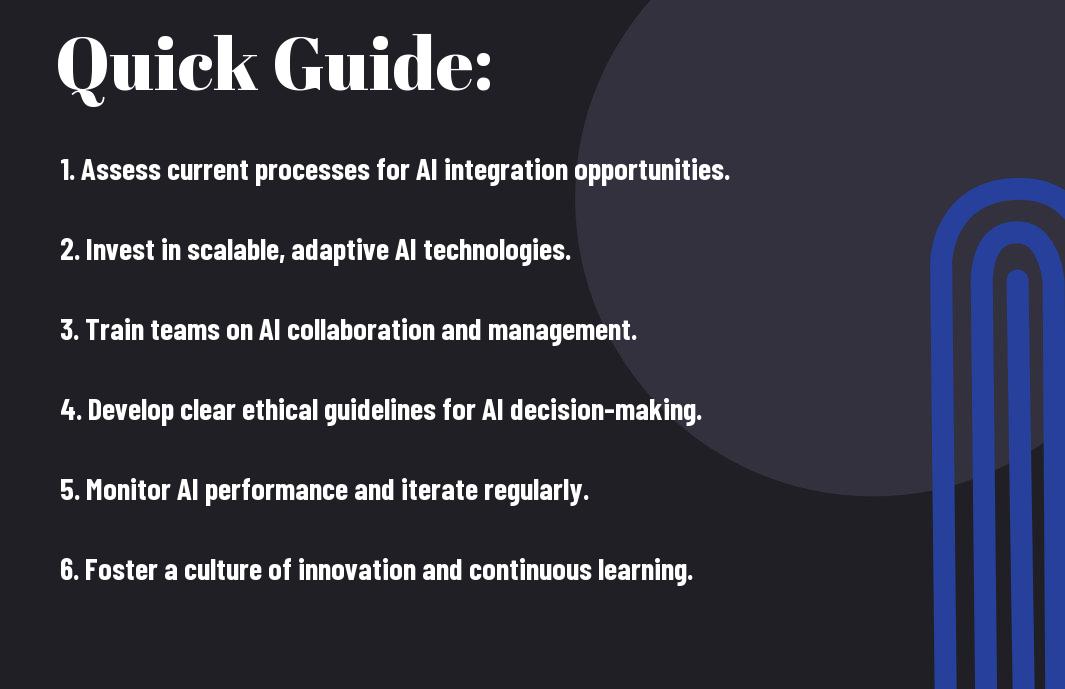AI technologies are rapidly evolving, and transitioning to agentic AI can significantly enhance your operational efficiency. In this guide, you will discover key strategies to ensure your organization effectively adopts agentic AI systems while mitigating potential risks. By understanding the benefits and challenges of this transition, you can proactively future-proof your operations, leading to improved decision-making and innovation. Let’s explore how you can position your business at the forefront of this transformative technology.
Key Takeaways:
- Embrace AI technologies incrementally; begin with pilot projects to assess effectiveness and scalability before a full-scale implementation.
- Foster a culture of collaboration between AI development teams and operational staff to ensure alignment on goals and enhance user experience.
- Invest in continuous education and training for employees to better understand and integrate AI capabilities into their work processes.
Redefining Roles: The Human-AI Partnership Revolution
In the evolving landscape of work, defining the roles of humans alongside an agentic AI system is vital. This partnership fosters an environment where human intuition and emotional intelligence complement AI capabilities, leading to enhanced productivity and innovation. Embracing this collaboration not only elevates performance but also redefines what value each party brings to the table. For deeper insights on this topic, check out Digital Twins, Agentic AI, and the Evolution of Work.
Shifting Perspectives on Workforce Dynamics
The future of work increasingly involves viewing human labor not as separate from, but integral to, AI technologies. Emphasizing a synergy rather than a rivalry enables your team to leverage the strengths of both human and machine, creating a more resilient and adaptable workforce. By reevaluating the skill sets required in today’s job market, businesses can enhance training programs to prepare employees for AI collaboration, ultimately fostering a more innovative workplace culture.
Identifying Tasks Best Suited for Agentic AI
Recognizing which tasks align best with agentic AI can transform your organizational efficiency. Focus on repetitive, data-intensive activities where speed, accuracy, and scalability are fundamental. For instance, AI excels in processing large datasets, conducting predictive analytics, and automating routine operations. Such tasks can benefit significantly from AI’s computational power, allowing your human workforce to redirect their efforts towards more strategic initiatives that require creativity and emotional intelligence.
Tasks traditionally deemed mundane, such as data entry and scheduling, can be effectively offloaded to agentic AI. By automating these processes, you free up valuable time for your team members to engage in higher-order thinking, problem-solving, and innovation. Moreover, integrating AI in customer service through chatbots allows for real-time responses to common inquiries, enhancing customer satisfaction. This not only boosts operational productivity but also nurtures a work environment where your employees can thrive creatively and strategically.

Designing Your AI Integration Strategy
Your AI integration strategy lays the groundwork for a seamless transition to agentic AI. This involves assessing your current workflows, identifying pain points, and determining where AI can drive efficiency and innovation. By strategically selecting areas that would benefit most from automation or augmentation, you set yourself up for long-term success while embedding AI into the fabric of your operations.
Mapping Current Operations: Where to Implement Agentic AI
Analyze your existing processes to uncover areas that could leverage agentic AI effectively. Focus on repetitive, time-consuming tasks that drain your team’s productivity. For instance, implementing AI-driven customer service chatbots can significantly reduce response times and free up human resources for more complex inquiries, thereby enhancing overall efficiency.
Setting Clear Objectives for AI Deployment
Defining clear objectives streamlines the AI integration process, ensuring that everyone involved understands the mission. Determine specific outcomes such as increasing operational efficiency by a certain percentage, reducing costs, or improving customer satisfaction ratings. Establishing metrics, such as a targeted 20% reduction in manual data entry tasks, will help guide your deployment strategy and facilitate performance assessments.
Setting clear objectives entails digging deeper into your organization’s aspirations with AI. You need to envision what success looks like and how agentic AI can help achieve that vision. For example, if your goal is to enhance predictive analytics capabilities, define measurable targets like improving accuracy by at least 15% compared to past methodologies. Regular assessments and adjustments ensure these objectives stay aligned with your evolving business goals, effectively positioning your operations to adapt and thrive in a rapidly changing landscape.
Cultivating a Data-Driven Culture
Shifting towards Agentic AI requires you to cultivate a data-driven culture within your organization. Engaging your team in understanding the value of data ensures that insights inform decision-making processes at all levels. This cultural transition encourages collaboration, innovation, and accountability, ultimately propelling your organization forward into Agentic AI – The Strategic Superpower Reshaping ….
The Importance of Quality Data for AI Success
High-quality data serves as the backbone of successful AI initiatives. Without clean, relevant datasets, your AI models risk yielding inaccurate predictions and insights. Investing in data quality not only enhances your operational efficiency but also amplifies your AI capabilities, giving you a competitive edge in your industry.
Strategies for Data Gathering and Management
Streamlined processes for data gathering and management are integral to maximizing your AI potential. Begin by establishing clear objectives for data collection aligned with your business goals. Leverage automation tools to capture data effectively and conduct regular audits to ensure cleanliness and relevance. Prioritizing security and compliance helps in building trust around data utilization.
Utilizing diverse data sources enhances your ability to draw comprehensive insights. Public datasets, customer feedback, and internal metrics should all be considered. Employing advanced analytics tools will aid in transforming raw data into actionable information. Encourage your team to regularly collaborate on data initiatives, reinforcing the collective responsibility to maintain data integrity and security. Keeping channels of communication open fosters a shared understanding of the value that quality data brings to your AI strategies.

Building Skills for Tomorrow’s Workforce
As you prepare for the rise of agentic AI, equipping your workforce with the right skills becomes imperative. This transition demands not only an understanding of AI technologies but also a readiness to collaborate effectively with these systems. Emphasizing the development of a future-ready workforce will ensure your organization remains competitive in the evolving landscape of everyday business operations.
Essential Skills for Collaborating with AI
Fostering collaborative problem-solving, data literacy, and adaptability are vital skills in an AI-enhanced workplace. Employees must understand how to leverage AI insights, navigate machine learning outputs, and communicate effectively with AI systems. With these skills, your team can maximize the benefits of AI, enhancing productivity and driving innovation.
Training Programs and Resources
Investing in robust training programs is fundamental to cultivating a workforce adept in AI collaboration. Online platforms like Coursera and Udacity now offer tailored courses focused on AI comprehension, data analytics, and human-AI interaction. Additionally, hosting internal workshops or inviting industry experts can provide hands-on experience, bridging the gap between theoretical knowledge and practical application.
Accessing diverse training programs enables employees to continuously upgrade their skills in line with the advancements in AI technologies. For instance, companies such as IBM provide resources specifically aimed at developing AI competencies across various roles. Additionally, engaging in community initiatives, like local hackathons or AI meetups, promotes skill sharing and practical application, allowing you to build a collaborative culture that’s attentive to innovation. Prioritizing these educational resources not only prepares your workforce for AI partnership but also contributes to a more engaged, knowledgeable team capable of driving your organization’s success.
Navigating Ethical and Social Implications
As organizations work toward implementing Your Own Agentic AI Workforce: Future-Proof and Scalable, understanding the ethical and social implications becomes imperative. AI-driven systems not only impact your operations but also the broader community, requiring a thoughtful approach to integrating these technologies responsibly. Addressing issues such as bias and transparency will not only enhance the trust of your workforce but also align your organization with the societal values that matter today.
Addressing Bias in AI Systems
Dealing with bias in AI systems starts with recognizing its prevalence in data. Algorithms often reflect the biases present in their training data, which can lead to unfair outcomes. By actively auditing and diversifying the datasets used for training, you can build models that are more inclusive and equitable. Implementing feedback loops where users can provide insights on AI decisions enables continuous improvement and adaptation.
Ensuring Transparent AI Decision-Making
Transparency in AI decision-making allows users and stakeholders to understand how AI systems arrive at conclusions. By adopting explainable AI techniques, you empower your team to scrutinize and trust the decisions being made. Features like model interpretability provide insights into the mechanics behind the AI’s output, reducing confusion and fostering accountability, which is crucial for the sustainability of any agentic AI initiative.
Pursuing transparent AI decision-making involves equipping your team with tools and knowledge to interpret AI outputs. Techniques such as LIME (Local Interpretable Model-agnostic Explanations) can help you break down complex model decisions into understandable segments, enabling stakeholders to grasp the factors influencing outcomes. Regular ‘AI explainability’ sessions can cultivate a culture of understanding and engagement, reassuring employees and customers alike that the system operates fairly and intelligently, ultimately reinforcing the credibility of your organization’s AI initiatives.
Conclusion
From above, it is evident that transitioning to agentic AI requires a well-structured approach that incorporates strategic planning, continuous learning, and effective collaboration. By evaluating your current systems, investing in training, and being open to iterative experimentation, you can ensure that your operations are not only future-proof but also adaptable to ongoing advancements. Embracing these key strategies will empower you to harness the full potential of agentic AI, fostering innovation and efficiency within your organization.
FAQ
Q: What is Agentic AI and why is it important for businesses?
A: Agentic AI refers to artificial intelligence systems that take proactive actions and autonomously make decisions on behalf of the user or organization. It allows businesses to automate processes, optimize operations, and enhance decision-making capabilities. Transitioning to Agentic AI is important because it equips organizations to adapt to changing market dynamics, improve efficiency, and foster innovation, thus ensuring long-term sustainability and competitiveness.
Q: What are some key steps to transition to Agentic AI?
A: To effectively transition to Agentic AI, organizations should consider the following steps:
1. Assessment: Evaluate current business processes to identify areas where AI can add value. This includes analyzing data and workflows to understand where automation can enhance productivity.
2. Pilot Programs: Implement pilot projects for AI solutions to gather insights and measure impact before a full-scale deployment. This approach helps in identifying potential challenges and fine-tuning the technology.
3. Skill Development: Invest in training and upskilling employees in AI technologies and data analysis. Building internal expertise will facilitate the integration of AI into existing operational frameworks.
Q: How can organizations ensure the ethical implementation of Agentic AI?
A: To ensure ethical implementation of Agentic AI, organizations should adhere to the following guidelines:
1. Transparency: Maintain clear communication regarding how AI systems operate and make decisions. Stakeholders should understand the data used and the reasons behind AI-driven actions.
2. Bias Mitigation: Implement processes to regularly assess AI models for bias and fairness. Use diverse datasets during training to foster inclusive decision-making frameworks.
3. Accountability: Establish a governance framework that defines roles and responsibilities for AI management. This includes addressing potential ethical dilemmas and ensuring that human oversight is maintained, particularly in situations where AI decisions impact individuals or communities.







